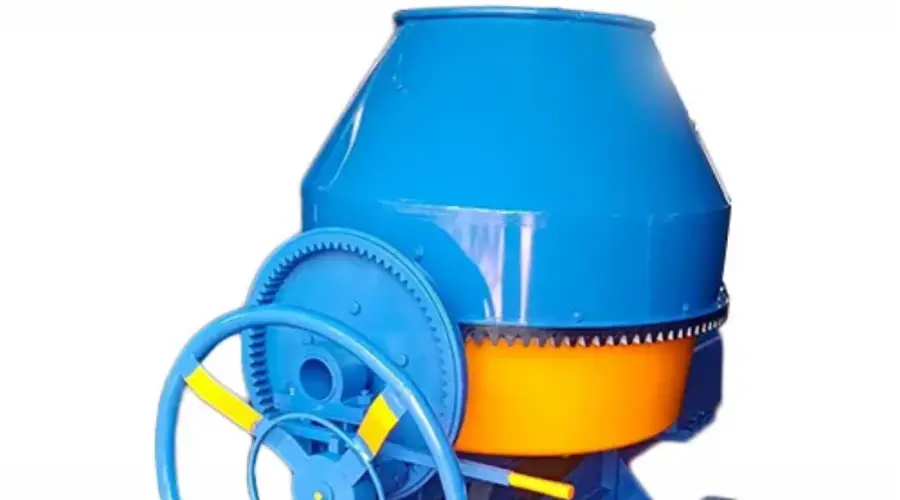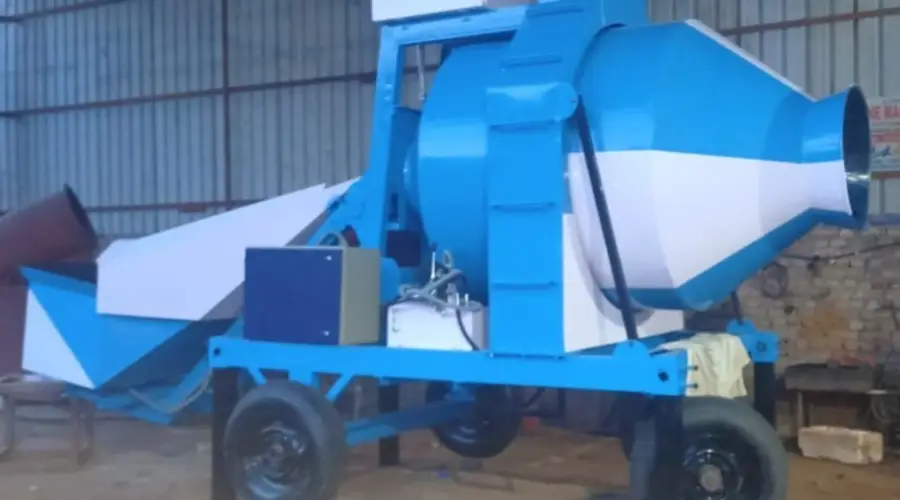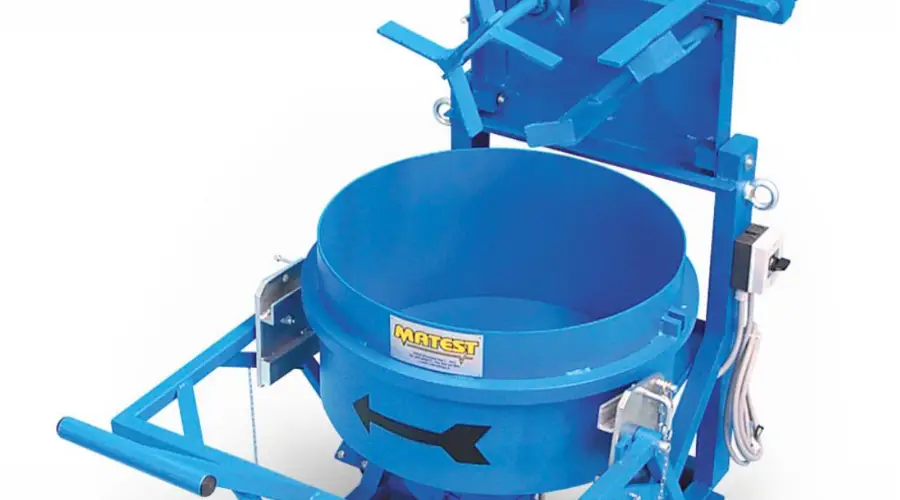Choosing the right concrete mixer is like finding your way through a city of tall buildings—each option stands out, but picking the right one takes careful thought. For small to medium construction projects, drum mixers are usually used, but are not ideal for high-rise building projects. Each project has its unique timeline to adhere to. Different types of mixers are used for different types of projects to improve their performance and efficiency of the work.
Let us explore these various options to uncover different types of concrete mixers that suit your upcoming construction project.
What is a Concrete Mixer?
Cement, water, sand and some aggregates are mixed at a particular proportion to obtain the appropriate concrete mixture. These components are mixed together in a machine and poured on the site or used for further construction work. These mixers are available in different sizes and types according to the project requirement, you may choose the best. From small portable mixers to industrial-sized mixers, there are various choices available in the market. The purpose of these various concrete mixers is to make concrete production quicker and more economical for the construction process.
Purpose of Concrete Mix
A concrete mix is a composite material that can be used for all sorts of construction works. It can be moulded into any shape and is known for its durability and affordability for every purpose. Cement, aggregates (such as gravel), sand and water can be mixed in precise amounts to provide a robust, long-lasting, and adaptable building material. The mixture offers:
- Structural Integrity: Buildings, bridges, and other structures are guaranteed to be able to bear loads and environmental conditions because of their structural strength.
- Durability: Over time, it can withstand wear, weathering, and chemical exposure.
- Workability: Makes it simple to pour, handle, and shape before setting.
- Versatility: Meets a range of building requirements, including those for walls, foundations, and ornamental elements.
- Customisability: This may be modified for particular projects by adding admixtures for qualities like increased strength, less shrinkage, quicker curing, or by changing the mix proportions.
Types of Concrete Mixers
There are various types of mixers available in the construction industry for mixing concrete. Let us explain briefly about their purpose and usage in the below passage.
Drum Mixer

A drum mixer, also called a barrel mixer, is used to mix big batches of cement or concrete. It features a revolving drum with internal blades that mix the materials as it rotates. Drum mixers are perfect for both small and large construction projects since they are effective, simple to use, and require minimal labour. They are capable of efficiently handling mortar, concrete, and other building supplies.
Different Types of Drum Mixers
Different kinds of drum mixers are used for various purposes that enhance the production of the concrete mix as well as contribute to the fast construction process. Drum mixers can be further classified into three types, which are as follows:
Tilting Drum Mixer
Tilting drum mixers are a common option for building projects when material needs to be unloaded rapidly. This is made possible by the tilting drum design, which allows the drum to be spun to pour out the mixed concrete or cement. In these mixers, the combined material is poured into a specific region from a drum that is inclined on its axis. Since the combined material may be conveniently discharged by tilting the drum, this type of mixer has the benefit of requiring less manual work than non-tilting drum mixers. They are therefore a well-liked option for modest to medium-sized building projects.
Non-Tilting Drum Mixer
In contrast to tilting drum mixers, non-tilting drum mixers rely on physical work to unload the combined material because they lack a tilting mechanism. The straightforward design and effortless operation of this concrete mixer are among its benefits. These mixers are well suited for both wet and dry combinations and can be used for small and medium-sized construction projects. In addition, they require little maintenance. Their incapacity to mechanically unload the mixed material is one of their primary disadvantages, nevertheless. For large-scale construction projects, this may be inefficient because large material quantities need to be unloaded..
Reversing Drum mixer

The material can be efficiently mixed by the mixing blades of a reversing drum mixer since the drum may rotate in both directions. Mixing blades, or fins, are mounted on the inside of the drum to help facilitate the mixing process. One of this type of mixer’s advantages is its ability to produce incredibly consistent concrete mixtures, including wet and dry mixes. They are easy to maintain and clean, making them appropriate for modest to medium-sized construction projects. They might be less appealing for some building projects, nevertheless, because of their comparatively high cost.
Pan-Type Concrete Mixer

Due to its round mixing pan, this concrete mixer is commonly called a pan mixer or circular mixer. The circular pan is mounted horizontally on a wheeled frame for easy mobility. Their capacity to create extremely uniform concrete mixes is one of the benefits. Additionally, pan-type mixers can be used to create a variety of concrete mixes, such as wet/dry mixes, mortar, plaster, and refractory materials. Their smaller mixing capacity in comparison to other mixer types is one of their primary disadvantages, though. They may not be suitable for larger building projects that require high-capacity mixing equipment.
Continuous Concrete Mixers
As implied by the name, the continuous mixer’s job is to load, mix, and discharge the mix continuously until the task is finished or a break occurs. Materials are continuously added using screw feeders. For very huge projects like dams, bridges, high-rise building construction, etc., continuous mixes are utilised.
Twin-Shaft Mixers
Twin-shaft mixers are strong devices made for mixing concrete of superior quality. Their dual-axis operation ensures efficient and consistent results, with well-aligned shafts and specially designed blades reducing mixing time and delivering uniform concrete.
Key features of Twin-Shaft Mixers:
- Shaft Alignment: Ensures smooth operation, reduces wear and extends the machine’s lifespan while maintaining mix quality.
- Mixing Efficiency: The dual-shaft design allows thorough, fast mixing, ideal for high-strength and precise concrete needs.
- Versatility: Suitable for various materials, including ready-mix, high-strength, and zero-slump concrete, making them adaptable for diverse projects.
These mixers combine efficiency, reliability, and versatility, making them a top choice for modern construction challenges.
Volumetric Mixers
As the name indicates, volumetric mixers are used to prepare concrete on-site and measure and mix concrete components as needed. They offer excellent efficiency and flexibility. They can be portable and act as mobile batching plants, allowing you to create custom mixes on demand and avoid excess waste.
These mixers keep cement, sand, water, and aggregates stored separately and combine them only at the point of delivery. This ensures fresh, high-quality concrete without issues like premature hydration or segregation.
Their mobility adds to their efficiency, enabling concrete production directly at the construction site. This reduces delivery time, costs, and the need for multiple trips to a batching plant, making volumetric mixers ideal for tight schedules and remote locations.
Conclusion
In conclusion, any building project’s success depends on selecting the appropriate kind of concrete mixer. Every type of mixer—drill, twin-shaft, continuous, pan, or volumetric—offers special benefits based on variables like project size, mix specifications, and operating effectiveness. To achieve high-quality, efficient, and economical concrete mixing, you can choose the best alternative by carefully assessing the particular requirements of your project and being aware of the capabilities of each type of mixer.

